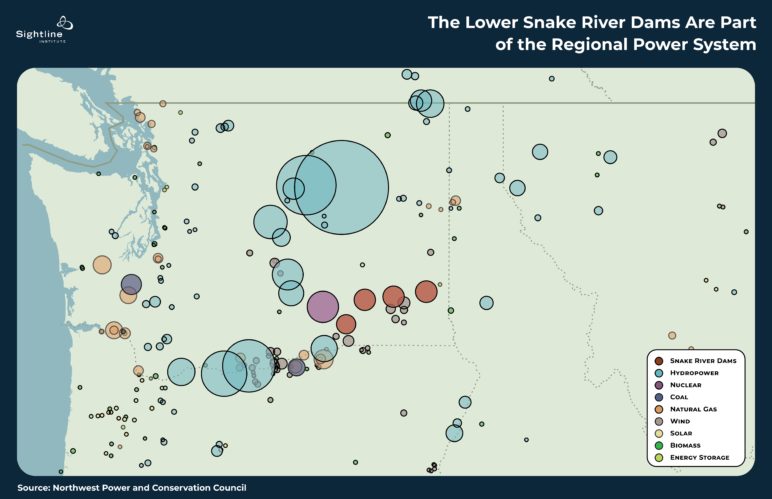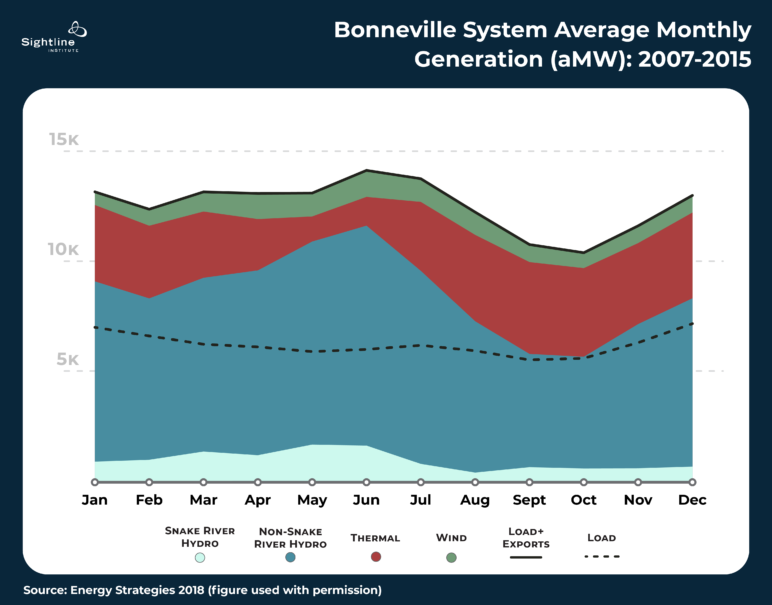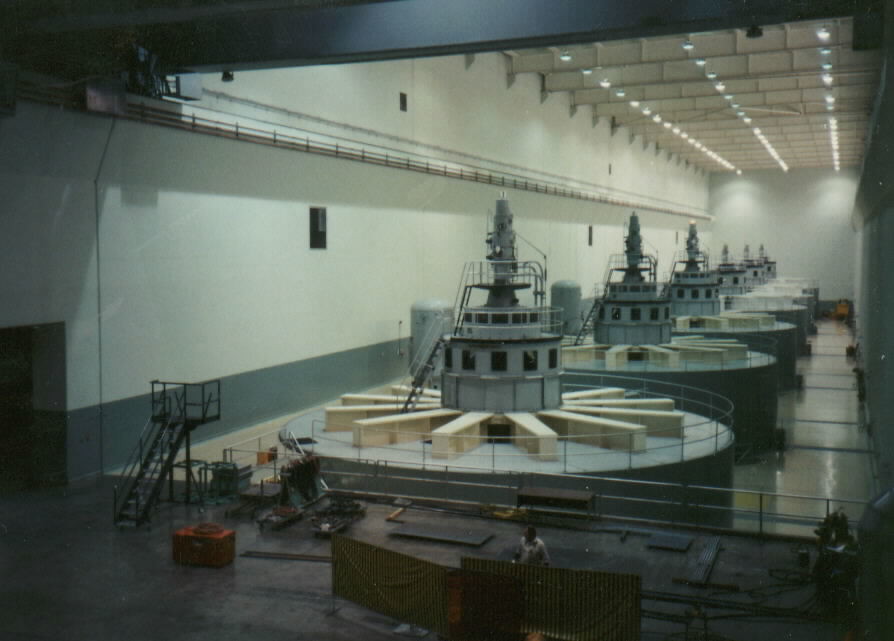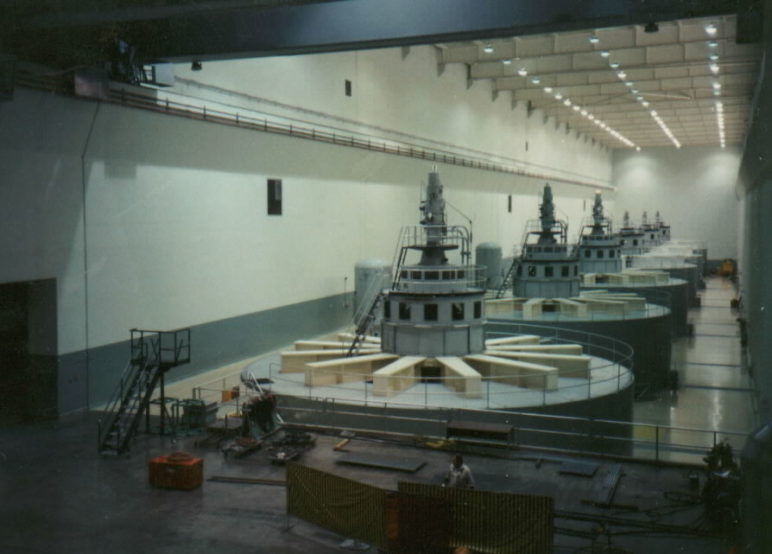The first article in this series made the case for removing the dams on the Snake River because of the importance we place on wild salmon, drawing on analysis from a recent report by ECONorthwest (ECONW). A second reason to remove the dams, beyond boosting the odds of salmon survival, is that they are no longer—or will soon no longer be—the cheapest option for generating the power that they produce.
Low-cost hydro electricity from the federal hydro system has provided a competitive advantage to the economy of the Pacific Northwest since the 1940s. But over time the dams, penstocks, turbines, and power lines aged and the costs of helping declining fish populations move through the system went up. In the last decade, a boom in solar and wind power has reset West Coast energy markets, undercutting not only coal-fired power but also aging hydro-electric projects.
The four lower Snake River Dams—Ice Harbor, Lower Monumental, Little Goose, and Lower Granite—have operated for half a century with a combined maximum capacity of over 3,000 megawatts. The dams are owned and operated by the US Army Corps of Engineers (the Corps). The Bonneville Power Administration (Bonneville) markets their output and delivers their electricity through its transmission system. The dams’ annual output is about 1,000 average megawatts, about one third of their peak capacity.
Figure 1 shows the maximum generating capacity of Snake River dams compared to all the other power generators in the region. The dams are considered “run of river,” which means they have relatively little storage capacity compared with other Northwest dams. Their output is highest in the spring as snow melts in the mountains and then electricity production falls in late summer and fall.

Original Sightline Institute graphic, available under our free use policy.
The bottom of Figure 2 shows the average monthly output of the lower Snake River dams in relation to Bonneville’s other generation sources used to meet the electric load of its contracted customers and exports to customers in and outside the Pacific Northwest. The figure shows the spring runoff that causes the overall hydropower system to peak in June and then fall through the summer. More than half of the region’s electricity generation is exported to utilities other than Bonneville’s public power customers. Bonneville customer load, shown by the dotted line, is highest from November through February for winter, with a slight uptick in demand during the late summer months.

Original Sightline Institute graphic, available under our free use policy.
The thermal generation shown in red includes the Columbia Generating Station near Richland, Washington, which generates about 1,100 MW of electricity. The balance of thermal generation includes two dozen smaller biomass, coal, and natural gas plants within Bonneville’s service area. Every two years, the nuclear plant is shut down for several months in the spring for service in order to coincide with the increased hydro output from the hydro power system.
The dams on the Snake River contribute between five and thirteen percent of Bonneville’s system output depending on the time of year. They have been fought over from their conception through present day. Tribes, fisherman, and conservationists have argued that they pose too great a risk to salmon. Ultimately, the benefits of low-cost hydro-electricity and in-land barge shipping won the historical argument. What’s less certain is whether the historic cost advantages of hydro will persist.
ECONW estimated the future costs of operating the dams for the next 30 years. To the annual operating costs reported in Bonneville’s 2016 hydro asset study ($52 million), ECONW added several costs that Bonneville left out: an estimate of the dams’ share of annual overhead costs ($15 million) and the wildlife program costs for the five endangered salmon species on the lower Snake ($76 million). ECONW also used the hydro asset study to estimate the future capital costs to operate the dams for the next 30 years. Because of the age of the Snake River dams and their turbines (and the expected life of this equipment), ECONW added the costs for the Corps to replace the turbines at a cost per megawatt equivalent to the recent $321 million turbine replacement at the McNary dam.
Using these assumptions, the average annualized costs to continue operating the dams for the next 30 years is $245 million per year. Given the uncertainty about future costs, ECONW evaluated a range centered around this single estimate. The dams average 9 million megawatt hours of output per year, so $245 million in annual costs implies unit cost of $27 per megawatt-hour. Given the uncertainty about the future, actual costs of power from the dams could range from $22 to $33 per megawatt-hour.
Read More:
Part I: An Overview of the Pros and Cons of Removing Snake River Dams
Part III: Removing the Dams and Agriculture
Part IV: What Would Removing the Dams do to Jobs?
Many people used to the history of Northwest hydropower being among the cheapest electricity around are surprised to learn that electricity at $27 per megawatt-hour from the dams on the Snake River may not be competitive with new electricity sources coming onto the market today. But consider that in March 2019, Idaho Power signed a long-term power purchase agreement from a solar project at $22 per megawatt-hour. In 2018, Xcel Energy of Colorado signed a wind plus energy storage contract at $21 per megawatt-hour. To be sure, the operating characteristics of the lower Snake River dams differ from wind and solar projects in ways that are valuable to grid operators, but these recent power purchase contracts have set the prices to beat for zero-carbon resources in the future.
In a March 2018 study sponsored by the NW Energy Coalition, Energy Strategies analyzed a replacement portfolio to offset all the electricity from the dams using wind, solar, energy efficiency, and demand response. Using the same forecasting tools employed by the Northwest Power and Conservation Council, the study showed how a combination of these new resources could replace the electricity from the dams while maintaining the regional grid’s stability and reliability. Energy Strategies estimated that the annual costs of a balanced renewable portfolio would be $464 million per year, almost twice as much as the $245 million estimate to maintain the dams.
However, the capital costs for utility-scale wind and solar have dropped by one third to one half since Energy Strategies did its study. Given the steady stream of long-term power purchase agreements for renewables priced in the low $20s, it is now an open question whether wind, solar, and demand response could provide carbon-free power more cheaply than the dams.
Like a lot of power generating plants in their fifth decade, the lower Snake River dams are unlikely to remain competitive in the emerging energy markets. Private utilities have shut down coal, natural gas, and hydro plants because aged facilities were too costly. Bonneville certainly has more expensive generating assets in its current portfolio, but when considered alongside the intrinsic value of helping salmon recover on the Snake River, the economic case for removing the dams on the Snake River and replacing them with wind and solar keeps getting stronger.
Next time: Making Snake River irrigators whole would cost surprisingly little.
Editor’s note, Oct. 22, 2019: This article was updated to more accurately characterize the composition of thermal generation within BPA’s service area.










Ross Coogan
Your economic analysis is flawed, you cannot add all the fixed costs pro-rated from the hydro overhead. These costs don’t go away with dam removal, instead make each asset more expensive. Using this rationale is self fulfilling for the dam removal community as then the fixed costs are spread over fewer units. Should be using the marginal cost of each asset for a realistic analysis. Then see if the economics work.